Make American Art Great Again
“The Lack of Constructive Analytical Criticism and the Proliferation of Descriptive Analysis in Contemporary Art” with James Little
Wednesday, November 15, 2017
Lunchtime Lecture Series, Art Students League, Phyllis Harriman Mason Gallery, New York
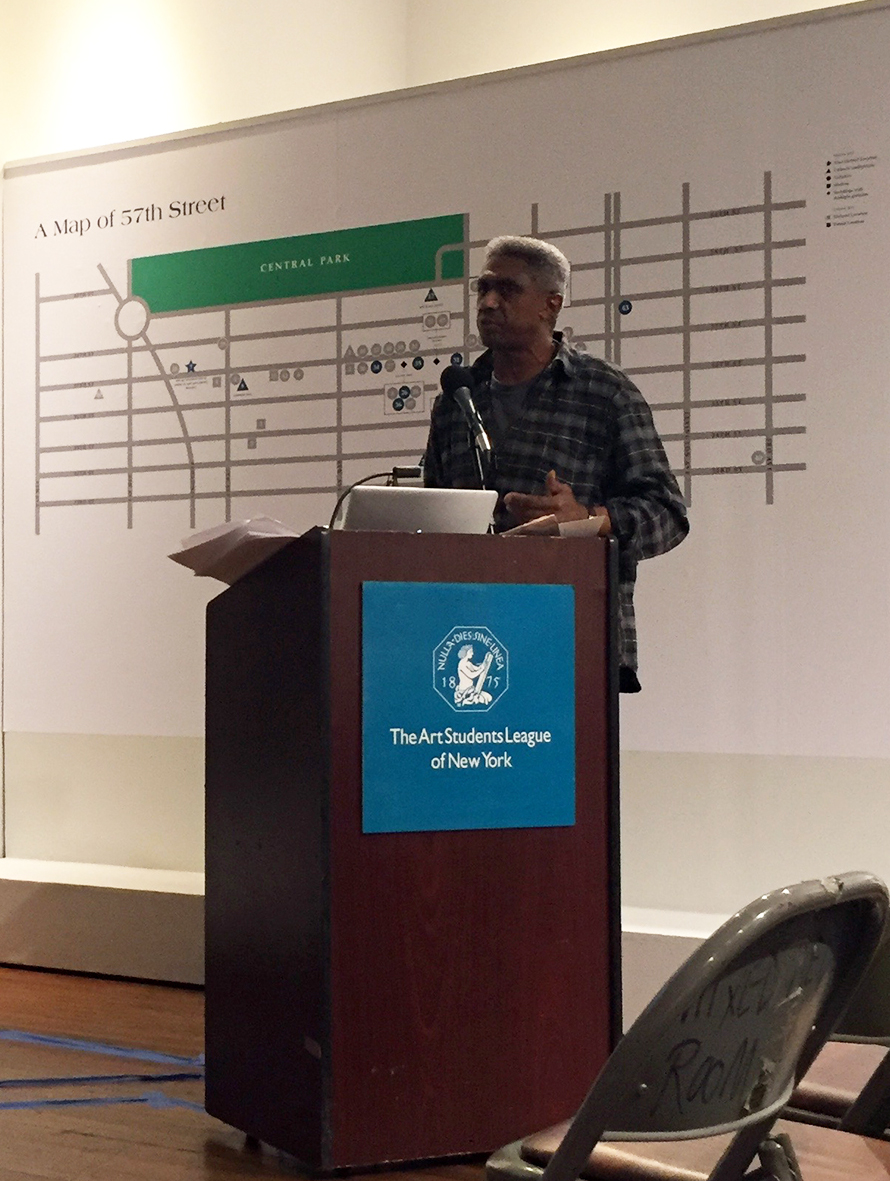
James Little (photograph by Christopher Howard)
The audience gathered in the Phyllis Harriman Mason Gallery of the Art Students League, a midtown Manhattan art school founded in 1875, was mostly middle-aged folks and senior citizens, with a scattering of younger people who were probably students. They arrived to see and hear James Little, an abstract painter and professor, give a lunchtime talk. I was unaware of him prior to the event—I did not know if he was a critic, an artist, or some other art professional before showing up. Born in Tennessee in 1952, Little earned his BFA from the Memphis Academy of Art in 1974 and two years later received an MFA from Syracuse University. June Kelly Gallery has shown his work since the late 1980s.
Today’s wordily titled topic, “The Lack of Constructive Analytical Criticism and the Proliferation of Descriptive Analysis in Contemporary Art,” felt like a time warp—meaning Little’s complaint was decades old. He characterized the current situation of contemporary art critics as a decline of quality that he likened to an “unedited book.” Critical debate, he claimed, has diminished since Clement Greenberg (1909–1994), Hilton Kramer (1928–2012), and Robert Hughes (1938–2012) were actively writing. An attitude of confusion was manifest in the most recent Whitney Biennial, he said, which included a 2016 artwork by Dana Schutz, whom he referred to as “Schultz,” that caused a controversy. Protesters accused Schutz, a white woman, of playing around with—and profiting from—the suffering of African Americans. “There was a big uproar about the fact that she did a painting of Emmett Till, Open Casket,” Little said. “The whole time, nobody said anything about the quality of the work. It was never mentioned…. What I recognized was that the critics weren’t stepping up, the artists weren’t stepping up, and we were just accepting this, accepting what they were feeding us, with no debate, with no criticism.” Little’s speaking style avoided complete sentences or thoughts. The supporting arguments behind his statements lacked substance.
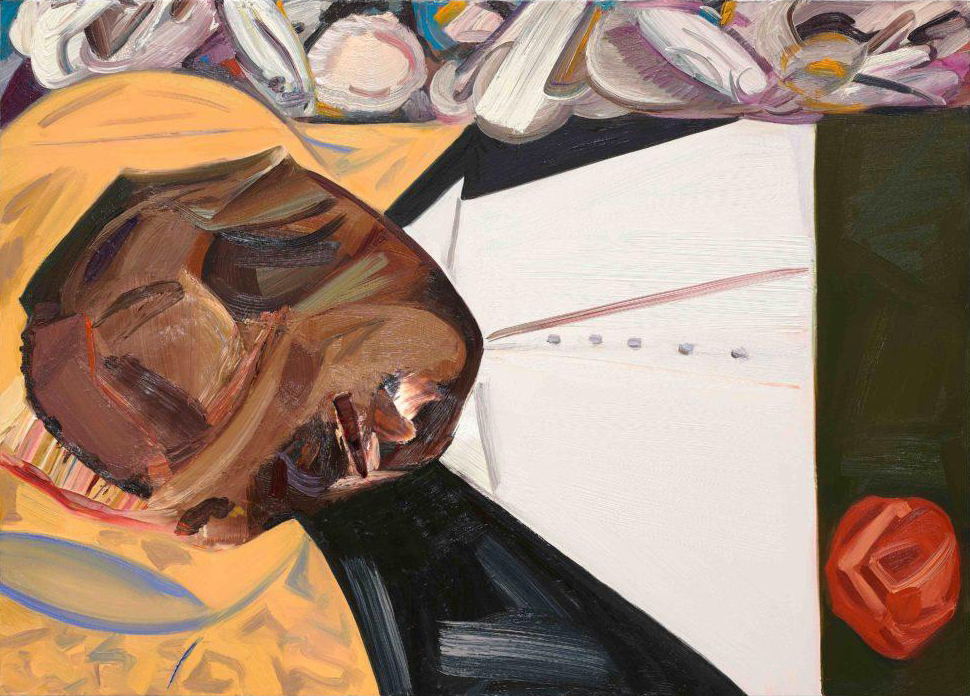
Dana Schutz, Open Casket, 2016, oil on canvas, 39 x 53 in. (artwork © Dana Schutz)
I was puzzled and wondered how much reading Little had done on the controversy. Coco Fusco avoided the topic of quality in a Hyperallergic essay, focusing instead on censorship. Calvin Tomkins, though, noted the “deftly brushed colors at the top” of the painting in his New Yorker profile last April. Elsewhere in the long read Tomkins wrote, “The horror is conveyed in painterly ways that, to me, make it seem more tragic than the photograph, because the viewer is drawn in, not repelled.” A New Republic piece by Josephine Livingstone and Lovia Gyarkye compared the painting’s formalism with its subject matter; it also contextualized Open Casket within Schutz’s oeuvre, noting the artist is not known for her solemnity. These three examples are the first ones I read while writing this review. If I had followed up with dozens more articles on the subject, I’d surely uncover further discussion of the painting’s formal qualities. Little declared that criticism is essential, that it improves art, provides direction for artists, and even offers them something to resist. Criticism can only do these things if a person reads it, which Little seems not to have done. I wondered if he actually saw Schutz’s painting in person instead of online.
Chris Ofili’s painting Holy Virgin Mary (1996), in the traveling exhibition Sensation: Young British Artists from the Saatchi Collection at the Brooklyn Museum in 1999, provoked New York’s mayor Rudolph Giuliani to call for censorship and defunding. “Nobody talked about the quality of that painting,” Little exclaimed. “Nobody said whether it was a good painting or a bad painting. Or if it was despicable. They didn’t say that. He made the guy famous. And that’s my point.” Later during the Q&A, Little agreed with an audience member that if Schutz had the skills, fewer people would have complained. “Dana Schultz was one of shock value. And she got it. She was in the right place to get shock value, and she got it in the Whitney. If she was a better painter, it could have been different. If it had been something, a personal experience of hers, it could have been different.”
The matter of a white woman painting a lynched black boy had little to do with the work. For Little, closeness to the subject matter is important. That an artist needs to experience his or her subject matter firsthand is an odd stance to take, considering that few painters in the Italian Renaissance witnessed the crucifixion of Jesus Christ or the beheading of John the Baptist. Maybe Little meant that an artist depicting current or recent events should bear witness to them, implicating an early text-based work by the artist Glenn Ligon, who riffed on the “I am a man” posters created in the wake of the 1968 sanitation workers’ strike in Memphis, which Little lived through as a teenager—though his recollection of basic facts of the event were faulty in several important ways. Nevertheless, Little was there but the appropriator was not, and therefore Ligon trivialized the situation.
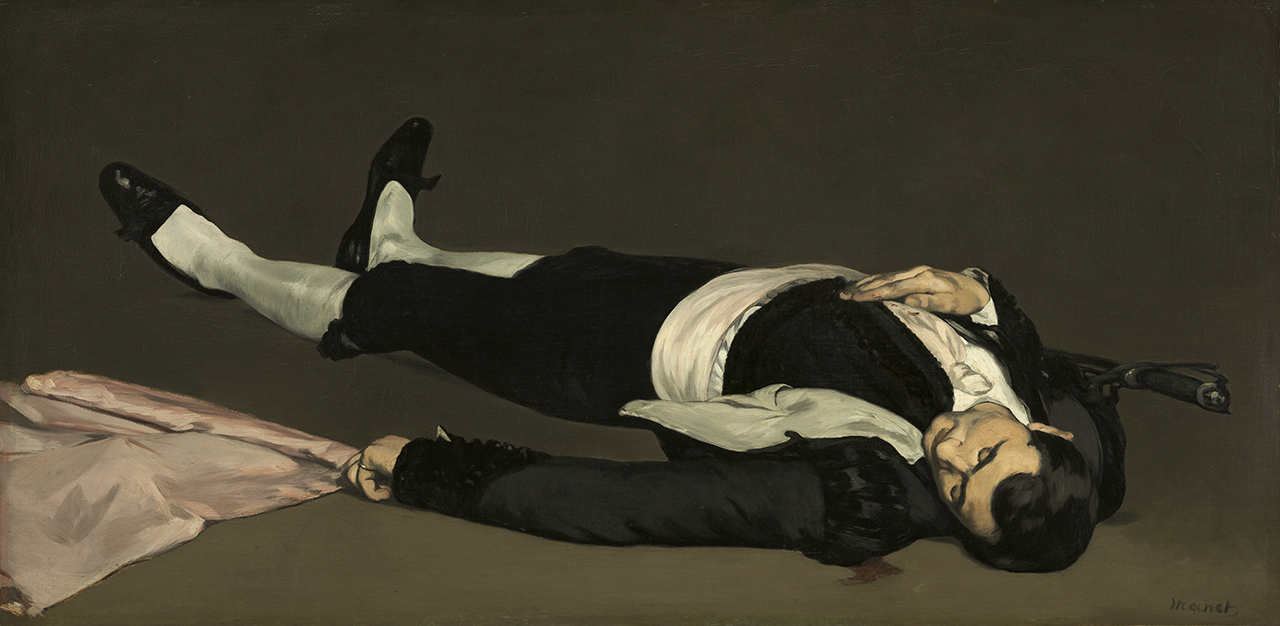
Edouard Manet, The Dead Toreador, probably 1864, oil on canvas, 29 7/8 x 60 3/8 in. (artwork in the public domain)
Little paired a slide of Open Casket with a work by Mary Cassatt—the first in a series of comparisons of art influenced by pop culture, the media, consumerism, and novelty (which was bad) with art connected to tradition (definitely a good thing). Contrasted here next were Paul Cézanne’s apples and Carl Andre’s bricks, then Marcel Duchamp’s Fountain (1917) and Édouard Manet’s The Dead Toreador (1864). Little showed an installation of rocks by Joseph Beuys called The End of the Twentieth Century (1983–85) and a painting from Claude Monet’s Haystacks series (1890–91). Little wondered how we got from one to the other without any critical debate, positive or negative. Once again, I was perplexed about this alleged dearth of debate. Hundreds if not thousands of books have been written on the evolution modern art. Bringing this specific painting by Manet was confusing. The artist had painted a bull in the picture, but critics wrote that it looked like a rat. Manet cut down the canvas and saved only the bullfighter. Does Little support critics having the power to force an artist drastically alter even a finished and exhibited painting?
Little periodically read passages from the writings of Greenberg, Kramer, and Hughes—critics whom the art world generally recognizes as having conservative views. The quotes were meant to buttress the artist’s “I am not a Duchampian” stance. Fair enough. Not every artist should embrace the readymade. Little further articulated his position: “I don’t think idea is enough to constitute art. I think art has to have vision, content—emotive content. It has to serve a purpose to humanity. It’s essential for our spiritual and mental health.” For Little, Andre is minor art, and “minor art is not major art.” Minor art that proliferates today is evidence of a cultural decline. “When art gets better, everything else gets better.” In other words, the relationship of art to life is a matter of trickle-up economics.
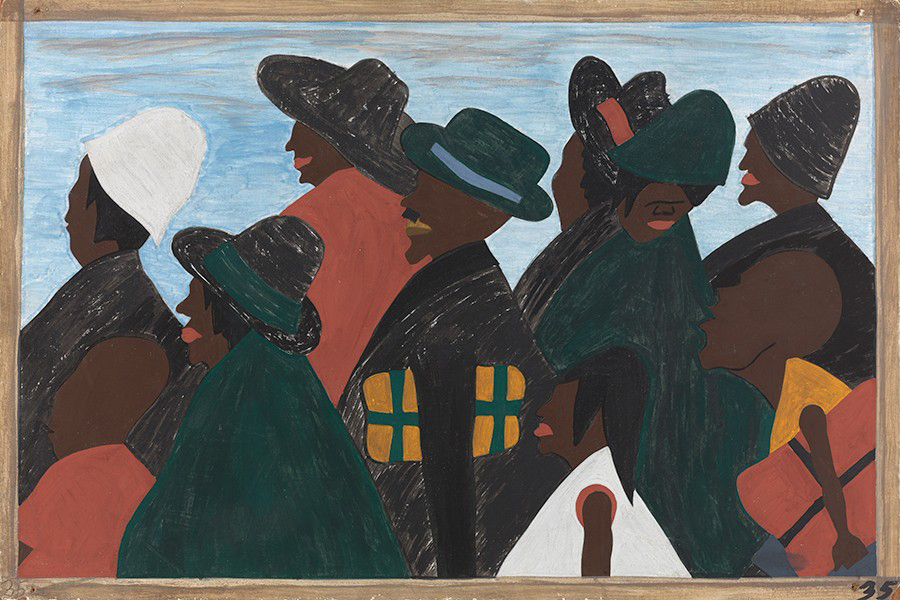
Jacob Lawrence, panel 35 of The Migration Series: They left the South in great numbers. They arrived in the North in great numbers, 1940–41, casein tempera on hardboard, 12 x 18 in. (artwork © Jacob and Gwendolyn Knight Lawrence Foundation)
Little said he felt nothing upon seeing Duchamp’s urinal or Beuys’s Felt Suit in a museum, but he marveled at Manet’s fallen bullfighter. “I had an aesthetic experience,” he said of his episode. “What I mean by aesthetic experience is the experience that you have when you see a great piece of art. It’s a life-changing thing.” Little’s definition of the aesthetic experience was wholly subjective, even tautological. You not only know it when you see it, but it’s completely explains itself. “Rembrandt is Rembrandt” was what Little stated to demonstrate the self-evidence of greatness. Art “has to offer something,” he continued. “It has to enrich my life and my experience in order for it to be art. It has to give me something I didn’t have in the first place. It has to take me further along in this journey.”
The three photographs comprising Ai Weiwei’s action Dropping a Han Dynasty Urn (1995) fail to meet his criteria for art, but paintings in Jacob Lawrence’s Migration Series (1941) do. Lawrence’s paintings speak for themselves as art, Little said, through a connection to the past, their color and composition, and their narrative. “An idea alone does not create an aesthetic experience,” Little reiterated. “An idea alone does not create art.” Little was agog at why Ai would drop a two-thousand-year-old Chinese vase, when a quick Google search would have turned up the answer. Sometimes an artwork doesn’t reveal itself immediately. Don’t we check the museum wall label to see who the subject of a portrait is? Does the iconography of ancient sculpture of Egypt or the Americas reveal itself to a nonspecialist? It needs interpretation.
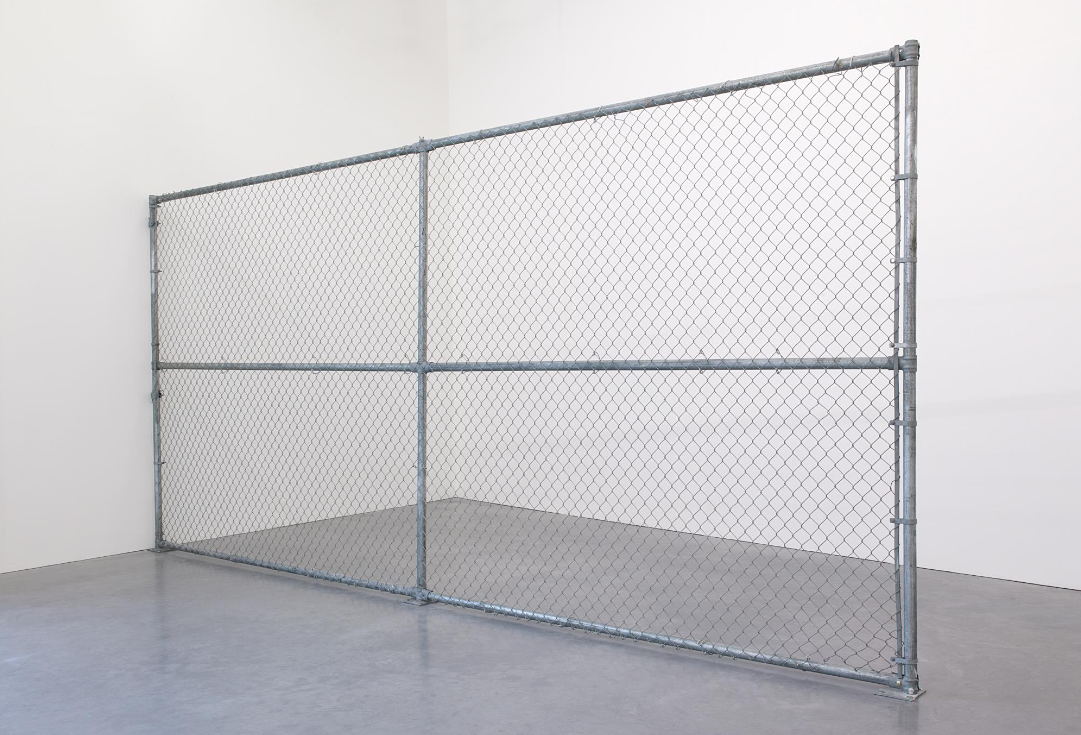
Cady Noland, Industry Park, 1991, zinc-plated steel chain link fence, 100¼ x 216 x 3 in. (artwork © Cady Noland; photographer unknown)
I sympathize with Little’s disbelief that a destructive act can be creative. I agree that rigorous formal training is a necessary precursor for a certain kind of artist—but not all artists. What puzzles me is how Little started the lecture by lamenting critical discourse, but then began condemning art he doesn’t like and pleading for a return to reason. I understood where he was coming from but failed to grasp a coherent argument. A photograph of Cady Noland’s Industry Park (1991), which consists of an unaltered chain-linked fence displayed in a gallery, was projected onto the screen beside him. People don’t see their lives improved by this art, he said. Art needs rigor to make. “We can no longer allow for the public to feed us stuff that we don’t understand, or don’t really matter to us in our daily lives.” Description, novelty, and consumerism has infiltrated criticism, and Little finds the writing of Robert C. Morgan, Karen Wilkin, Mario Naves, and James Panero to alleviate this. Is it because they praise art he likes and denounce art he hates?
A chain-linked fence does not reach the masses, Little remarked during the Q&A. Noland’s work does not provide an aesthetic experience. It’s only utilitarian. The Art Students League has provided traditional artistic training for decades, he reminded the audience, educating Jackson Pollock, Louis Nevelson, Roy Lichtenstein, and Robert Rauschenberg. “We can’t throw this [tradition] out the window, you know, because somebody decides they want to go out here and take a chain-linked fence and put it up in the Museum of Modern Art. And we look at it like it’s some, you know, revelation. No, it’s not a revelation! That’s what I’m saying! I’m gonna go get me a chain-linked fence when I leave here, and I’m gonna put it in my backyard. Is there any difference? Well maybe it’s Earth art.” Little has seen art exhibitions of trash swept into a corner—a clichéd insult that is ironically based on real life—and a room full of grocery carts. (Could the latter show be Josh Kline’s recent solo outing at 47 Canal?) Little admitted he was a conservative formalist, which he confidently understands as meaning “I know what I’m doing.” He obviously demands high craft and skill from artists, who make their work by hand, with a vision, and a sense of history. Further, Little feels he belongs more to the late nineteenth and twentieth centuries than to the twenty-first. He does not make art for himself but rather is concerned what others think and feel about it, including his fellow artists.
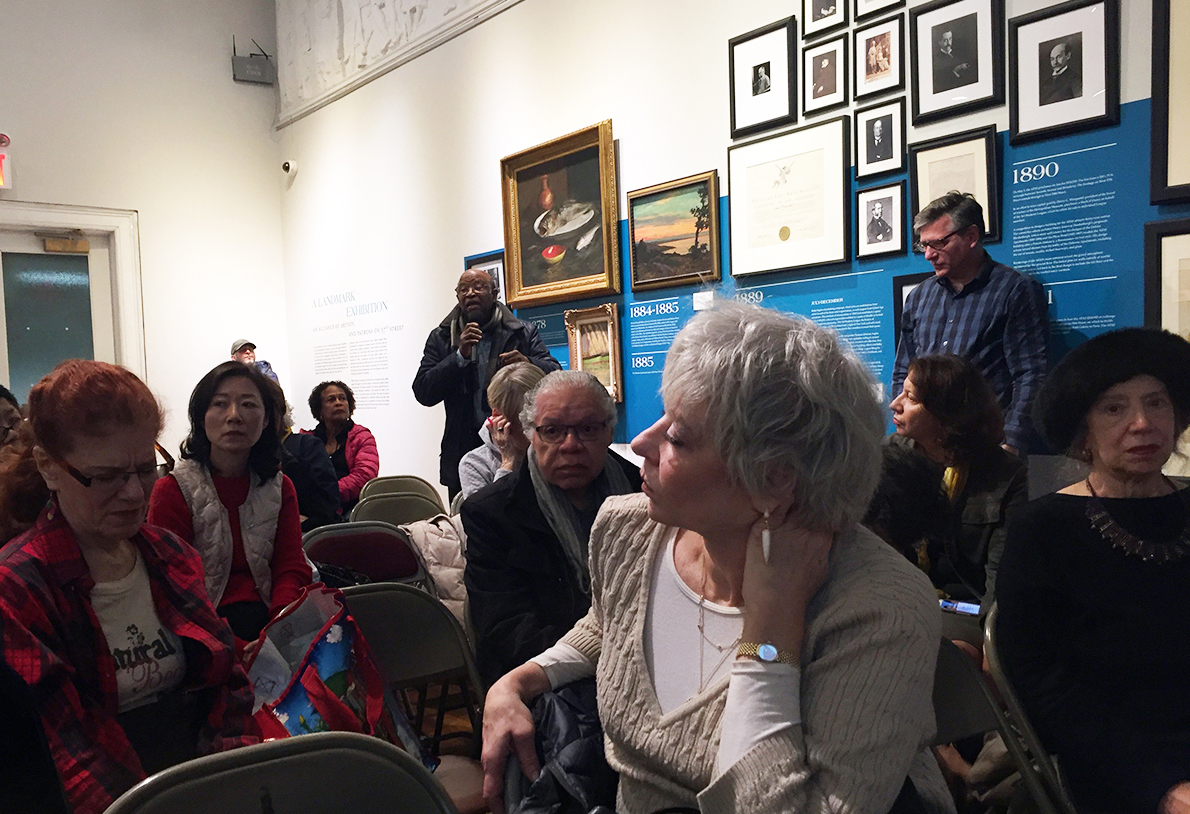
An audience member speaks during the Q&A (photograph by Christopher Howard)
During the Q&A an audience member asked about the connection between Rembrandt and Pollock. Thomas Hart Benton, Little replied, served as the lineage of formal training, which includes studying classical art and knowing the figure. “Where [Pollock] took it was another place.” Pollock had “developed a relationship with the medium” of paint and expressed himself through paint. Rembrandt was connected to Titian, El Greco, and Leonardo. “Look, if you gonna built a house, would you build it without a foundation? I guess not.” Someone else argued that Duchamp and Beuys attempted a dialogue with the past. “What you just said is right on,” replied Little. “They were trying to do that. I’m saying that they didn’t do it…. The others, they weren’t trying to do it—they did it.” Little returned to Beuys’s Felt Suit. “When I walk past this suit, at the Walker Art Center, it did not do anything for me. That’s just the way it is. It just didn’t do anything for me.” The work presented a conundrum. “Why is this here?” he wondered. “Why is there not an outcry against this art? Critics have failed us. I pray for another Clement Greenberg, and Hilton Kramer and Robert Hughes. I pray for it because we don’t get that.” Little contented that we have failed to uphold standards. That “we” includes artists, scholars, curators, museum professionals, and the public. Little was not surprised that art mocking middle-class values has found an audience among the wealthy elite who fund art museums and serve on their boards. One attendee remarked, “Whose interest does that serve?” The lecture thankfully ended before a discussion of collecting practices began.
Earlier this year Bomb interviewed Little for the magazine’s Oral History Project. “His paintings are guided by intuitive responses to form, color, and feeling,” LeRonn P. Brooks wrote in his introduction to the piece. “This approach is not overly calculated, though its complexity may suggest so.” Little was interviewed by the Brooklyn Rail in 2009 and profiled by ARTnews in 2011. In the latter, he described his process in detail, describing how he applies layers of paint (made from powdered pigment and mixed with varnish and beeswax) to his surfaces to produce a high sheen. Though I disagree with most of what he said, Little’s views did not put me off. In fact, I am curious to see his paintings in person, to understand why he believes the things he does and how his vision for art manifests itself in his own production. I don’t wish to persuade him of accepting the value of Duchamp, Beuys, and Noland. How he feels about his own art is of greater interest and importance.
In Terms Of count: coming soon.


